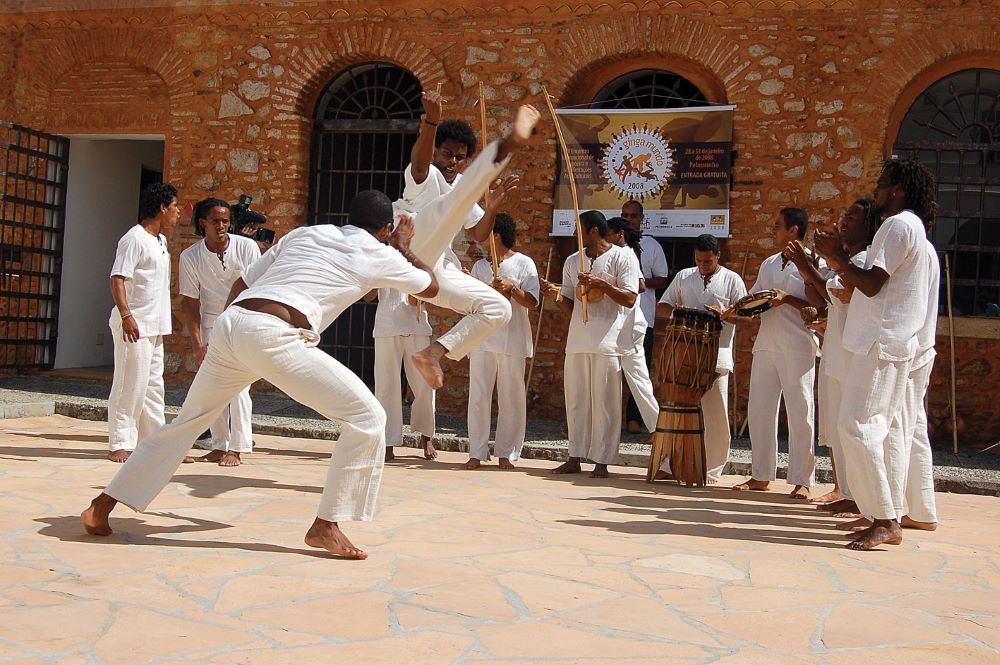Brazilian Jiu-Jitsu is known all across the globe. Due to the popularity of mixed martial arts seen over the past decades, the Brazilian version of this Japanese martial art has gained a large number of followers. However, another Brazilian martial art also deserves recognition. Named Capoeira, it was created by enslaved Africans in Brazil. With millions of followers around the world, Capoeira is a mix of martial arts, dance choreography, acrobatics, fitness practices, and the preservation of West African tradition.
The date when Capoeira was created is uncertain. Some historians believe it may have emerged in the 17th century in Salvador or Rio de Janeiro. But one thing is for sure; Capoeira was created as a response to the violence enslaved Black people were subjected to in colonial and imperial times in the largest country in Latin America.
With blows and fast body movements, Capoeira allowed many Afro-Brazilians, who fled farmers to unexplored areas in the country, to defend themselves from brutal persecution.
Despite the repression and brutality against Capoeira, which turned into an illegal practice for three centuries, it spread in many places, overcoming laws that were created to ban it. In order to disguise the martial art, Capoeiristas adapted the movements and added choreographic and musical elements, camouflaging their true purpose. They also used Capoeira songs as a means of communication to plan escapes from the farms.

Music is one of the elements that distinguishes this modality from other forms of fighting. It is even essential for the practitioner to be considered a complete Capoeirista. In addition to body movements, practitioners must also know how to play instruments of Afro-Brazilian origin, such as the berimbau, a single-string percussion instrument, which is the main instrument and also the most famous associated with Capoeira.
Its popularity was immense and the art form remained even after the abolition of slavery in 1888. At the same time, the Brazilian repression against Capoeira persisted and even worsened after the emancipation act freed enslaved Afro-Brazilians. Until the mid-1950s, Afro-Brazilians who were caught practicing Capoeira at the time of prohibition were incarcerated and led to forced labor.

In 2014, Capoeira was added to UNESCO‘s intangible cultural heritage list for its importance as well as its cultural and historic value.
To learn and play Capoeira, it is important to understand that it requires great skills, such as flexibility, mobility, rhythm, acrobatics, core strength, and power. Its practice can be considered a kind of ritual. While two people are fighting against each other, the other players around the circle sing, chant, clap, and play percussive instruments. Capoeira circles are formed by a group of people of any gender and comprise a master, counter-master, and disciples.

The master is the bearer and guardian of the knowledge of the circle and is expected to teach the songs and maintain the group’s cohesion and its observance of the ritual code. The master usually plays a berimbau, starts the chants, and leads the game’s timing and rhythm. All participants are expected to know how to make and play the instrument, sing a shared repertoire of chants, improvise songs, know and respect the codes of ethics and conduct, and perform the movements, steps, and strikes.
Today, Capoeira is considered one of the greatest Brazilian cultural manifestations and is recognized worldwide as a practice that unites sport and art. People of all ages from different regions practice Capoeira, a martial art that not only teaches people how to fight, but also fosters a sense of community among Afro-Brazilians, their history, and their culture.
Related: Meet The Man Teaching Capoeira To Black NYC Youth To Connect Them To Their Heritage
